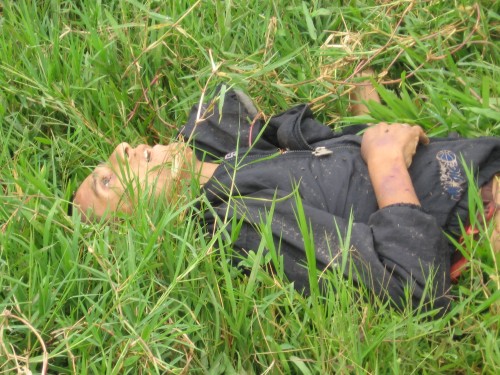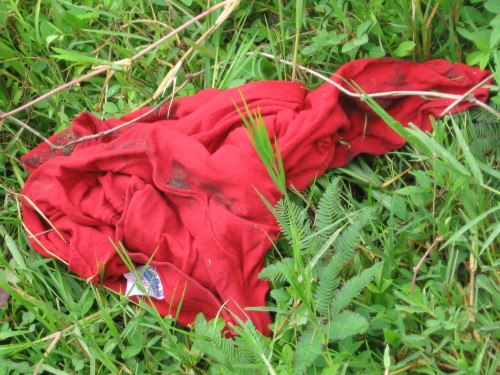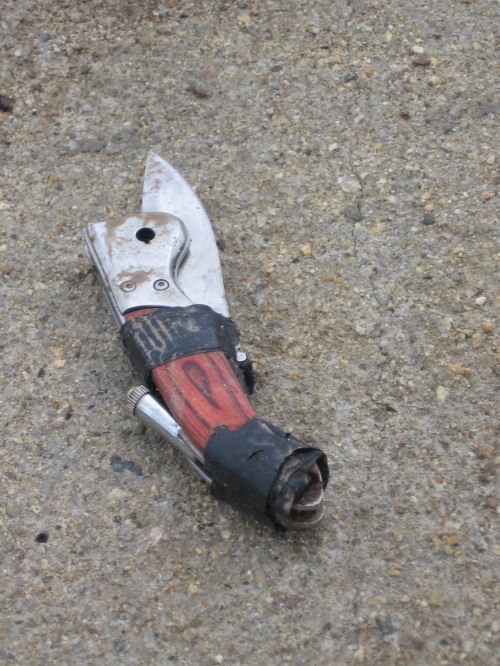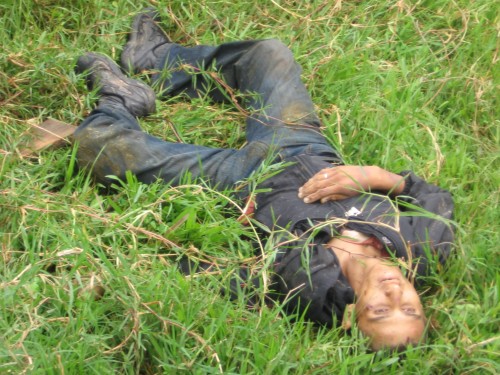Sector López Arellano, Choloma, Cortés, Honduras
August 9th, 2009.
by Sandra Cuffe
Juan Gabriel Figueroa Tomé was 30 years old, married, and had two small children. He worked as an employee of the Municipality of Choloma. Together with friends and work colleagues, he participated in the resistance marches and activities against the coup from June 28th itself until his murder in the wee hours before dawn on Saturday, August 8th.
The young worker’s cadaver was found with a bullet wound in the nape of his neck and another wound to his thorax in an area known as La Platanera in the Lopez Arellano Sector of Choloma, Cortés department, Honduras. According to the forensic doctor, Figueroa was murdered at approximately one thirty in the morning on Saturday. His death, however, turned up in the Sunday newspaper not as political news, but in the violent ‘Incidents’ section as but one more nameless statistic among so many other daily murders in the region.
Upon hearing the news of Figueroa’s death, many people walked under the relentless sun along the dirt streets of the López Arellano Sector to the wake at the home of Figueroa’s parents. Even before his body was released from the judicial morgue of San Pedro Sula on Sunday, relatives, friends, neighbours, colleagues, and resistance movement participants began arriving at the house to share the sorrow and express their solidarity with the grieving family.
Photos of Figueroa, smiling and full of life, hung on the walls.
Figueroa’s son was crying in his aunt’s arms, but when asked how old he was, he perked up enough to hold up four fingers on one hand before burying his face into his aunt’s shoulder.
Figueroa’s five-year-old daughter held out her hand in greeting and appeared ecstatic, as though people were filling the humble home for a party, instead of coming to bid farewell to her father, whose body rested in a coffin in the small living room.
“She says that her daddy is sleeping,” explained Figueroa’s mother, when asked what the children understood about the situation.
Between greetings and hugs from other women in the house where she raised her son, Figueroa’s mother spoke about how her son would sometimes go out with friends on weekend nights to set up a small vendor’s stand at soccer games and then have some fun before returning home on his friend’s motorcycle. Acquaintances had seen Figueroa close to midnight at a dance party, while others claimed to have seen him playing pool at around 12:30am in a local pool hall.
Known locally as an extremely dangerous area in the sector, the La Platanera is somewhat removed from the routes between the stadium, the dance party, the pool hall, and Figueroa’s house. His relatives confirmed that he never traveled through that area.
“They took him there because no one recognizes him there,” said Figueroa’s mother. “It wasn’t until later in the morning that someone who knew him passed by and came to tell us,” she explained.
Figueroa’s mother also explained that her son was not killed in the exact location where his body was found, but further down in that same area, where there was “a pool of blood,” she said. He was also found without his identification documents nor the yellow motorcycle he was riding the night of his murder.
The young Juan Gabriel Figueroa Tomé was the only member of his family to actively participate in the resistance movement against the coup. Sobbing, his mother expressed that everyone who knew him is asking why he was murdered, adding that he was a respectful worker who loved his family and his neighbours, and that he was not involved in any criminal or dubious activity.
The López Arellano sector is within the region with the highest murder rate in the country, in a sort of triangle between greater San Pedro Sula, Choloma, and El Progreso. This region with the greatest levels of violence, and also of femicide, coincides with the corredors of maquilas, factories, and tax-exempt Export Processing Zones (ZIPs), in which all kinds of clothing and other consumer goods are factory-made for export, mainly via the country’s principal port Cortés to the United States.
Despite Figueroa’s mother’s questioning of the motive of her son’s murder, one of his best friends asserted that many people have little doubt that Figueroa was killed because of his participation in the actions coordinated by the National Front in Resistance to the Coup, explaining that “since the 28th [of June] we have been there in the resistance – in San Pedro, in Choloma, in the marches, in everything we were there together.”
At two in the afternoon, a funeral mass was held in a local church that same Sunday, August 9th. There were not enough chairs for the throngs of people who attended, and thus many stood along the walls and even outside the church doors.
“Sometimes, we ask ourselves: Why the violence? Sometimes we ask ourselves why he was murdered in this way,” the priest preached.
“This murder was carried out to send a clear message to the people in this sector and in the northern region in general,” remarked a human rights activist and active participant in the resistance movement who attended the funeral in solidarity with Figueroa’s family.
“They are not killing well-known leaders from the Frente or organizations, but instead workers, farmers and teachers who are not well known but who have been actively participating in the resistance,” she explained. “Murdering individuals with whom ordinary people can identify is a clear counterinsurgency tactic to terrorize the population. Furthermore, because of the age of most of the martyrs, the murderers are demonstrating more and more clearly that they view the widespread participation of youth – the majority in this country – as a serious threat.”
Upon leaving the church after the funeral at around three in the afternoon, a friend of Figueroa’s approached with more news. Neighbours had reported that during the wake that same morning, armed men on a motorcycle had been driving back and forth along the street in front of the home of Figueroa, his wife, and their two small children.
Furthermore, Figueroa’s friend explained that neighbours of the area where Figueroa was murdered had already been talking about unknown men on two motorcycles chasing someone through the area at about one in the morning the same night of the murder. According to the second-hand testimonies, the man being chased stopped and shouted that his pursuers could take his motorcycle without a problem, because he would not resist.
“It’s not the chopper we want. It’s you we want,” said his pursuers, according to the neighbours’ testimonies.
“Around here, nobody sees anything – you know, out of fear,” clarified Figueroa’s friend, when asked about the description of the men and the motorcycles. “It may be that people tell of things they have heard during the night, but nobody sees anything…”
The wind blew through the dusty streets, bringing cool relief to the congregation of people getting ready for the funeral procession to Figueroa’s burial in a local cemetary. Many women were crying as they left the church, while the men seemed to attempt to distract themselves from the cries and hugs. As always, the smallest children played and laughed, bringing smiles to the faces of those watching them.
Sitting on the sidewalk outside the church, a local leader of an organization involved with the National Front in Resistance against the Coup in Honduras was talking to someone on his cell phone about the murder, about the ongoing death threats he himself received, and about the thousands of people participating in week-long resistance marches that were nearing the two main cities in the country. It became evident that he had been asked why he and so many thousands of people continued in resistance when they were being met with such strong repression by the de facto government.
“Well, first of all, because I love my country…”
# # #
This article was originally published in Spanish on August 9, 2009. At the request of Juan Gabriel Figueroa Tomé’s family, no photographs were taken. Similarly, out of consideration for both privacy and security, no person has been directly named except for Figueroa himself, considering that both his murder and his participation in the resistance to the coup are already public knowledge.
Sandra Cuffe is an independent journalist and photographer from Canada. She lived in Honduras from 2003 to 2007 and returned to the country on July 3, 2009. She is currently a contributing member of the Dominion (Canada), a contributor to Upside Down World (USA), a correspondent for Defensores En Linea (Honduras), and maintains a bilingual blog: http://HondurasSolidarity.wordpress.com
# # #




